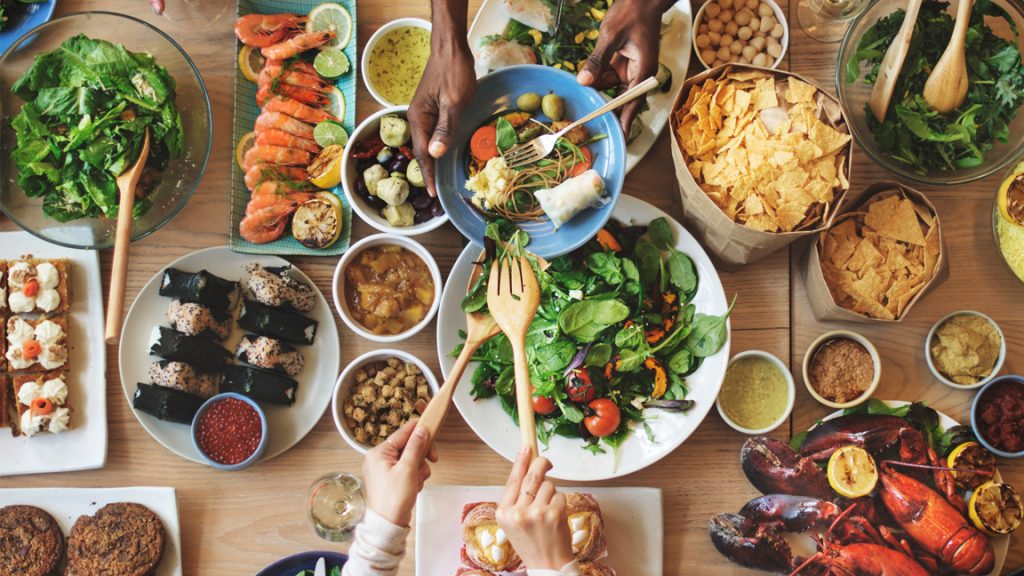Less salt when cooking doesn’t mean less flavor, you have the alternative of using some herbs and spices. Your taste buds will barely notice the difference but your heart surely will.
I know a lot of people who add salt to their meals without even tasting the food. High amounts of salt, known as sodium in your diet is unhealthy on many levels. It can cause hypertension, heart diseases, water retention, weight gain, stomach ulcer and stomach cancer. It is also not convenient for people suffering from kidney problems.
Small amounts of sodium present naturally in the food are good for us. We need this mineral in small amounts to compensate for the sodium loss that usually occurs when we sweat and urinate. Too little can cause spasms (sudden contraction of muscles), poor heart rhythms, sudden death and even increases the risk of heart attack in hypertensive patients.
Just how much salt do we consume?
According to the Food and Drug Administrations, the average salt intake is one teaspoon a day, which is a daily quantity of 2,400 milligrams. High sodium intake becomes unhealthy when we start to include it in almost all our meals or drinks.
There are several ways to cut down on salt intake, such as avoiding processed foods, reading food labels before purchasing, planning home-cooked meals instead of ordering from outside. But some foods have hidden salt content, and you should be aware of that.
Here are some common terms and their meanings:
Sodium-free – less than 5 milligrams of sodium per serving
Very low-sodium – 35 milligrams or less per serving
Low-sodium – 140 milligrams or less per serving
Reduced sodium – usual sodium level is reduced by 25 percent
Unsalted, no salt added or without added salt – made without the salt that is normally used, but still contains the sodium that is a natural part of the food itself
According to the US Food and Drug Administration and US Department of Agriculture state, food that has the claim of ‘healthy’, must not exceed 600 mg sodium per labeled serving size.
Breakfast cereals: They may be sweet and tout health benefits, but may contain high levels of sodium. Read the label well.
Bread: The best options will be brown or whole wheat. But other healthy breads might contain high amounts of sodium like bagels, white baguette, French toast, or chapatti. Check the label.
Cheeses: Can be very high in sodium if you consume the wrong kinds. Usually all kind of cheeses are high in salt, from white to yellow to processed ones. So be cautious about the right choices, choose the cheeses that say ‘low in sodium’. Low-fat cheeses are not necessarily low in salt!
Soups: Many canned and instant soups contain more sodium than home-made soup. At least, when you prepare your own soup, you are aware of the quantity of salt you are adding, so you can control it. Again, check the label and look for the least sodium content when buying store-bought variety of soup.
Soy Sauce: Soy sauce, a condiment used in Asian cuisine, is usually high in salt, and excessive use can turn a very healthy sushi meal into a high blood pressure one. To avoid this, choose low-sodium soy sauce, especially for seafood dishes as they are already high in sodium, so no need to add extra salt to it.
Pasta sauces: Pasta sauces contain a lot of sodium, specially the canned tomato sauces. Look at the label for the least amount of sodium before buying the product. Another solution is to make your own sauce at home.
Additionally, any drink or soda (Pepsi/cola/ seven up) containing sodium, sodium glutamate, monosodium glutamate, and sodium citrate should be consumed only occasionally.
You should also watch what type of mineral water you buy, look for the least sodium content: 2 to 4 mg of Sodium is considered a good range.
Usually, on the first weight loss visit at my clinic, I perform a test that measures the water, fat and protein proportions in the body.
Some clients show a high water mass in their body, which is mainly caused by salt consumption due to the quantities of sodium hidden in certain food items, more than just adding table salt to their foods.
If water mass is high, a carefully-selected, varied and low-sodium diet will help them lose a lot of weight on the first week of diet.
While sodium consumption is necessary for everyone, too much sodium in the body can make you feel bloated, constipated and tired. It can also cause migraines for some people. Women should particularly watch their consumption of sodium before their menstrual cycle, as they are tempted to retain more water in their body.
Pregnant women should also avoid high consumption of salt which will cause problems for her and for her baby.
People taking certain medications like cortisone should cut off the sodium completely from their diet. Cortisone already causes bloating, so they don’t need extra water retention from salt consumption.
High sodium consumption is also one of the reasons for cellulite development. I should mention about Himalayan Crystal Salt, which has shown excellent results in treating hypertension, bloating, and many other cases.
Unless your health demands it, the average person does not have to live on low-sodium foods all the time. As long as you are somewhat healthy, you just have to practice moderation. You can enjoy your favorite extra-salted meal or food item from time to time. But always drink a lot of water when eating sodium-containing foods.
To subscribe to my diet programs, don’t forget to log in to: www.eatlikemira.com.

